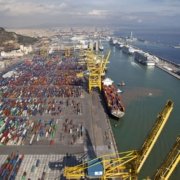Back to Basics: Blue vs. Green Hydrogen
Anyone who follows current events knows that we are currently in a race against time when it comes to offsetting the effects of global warming. Transport emissions are a key part of this race as, in today’s globalised society, they contribute significantly to the rises in temperatures throughout the globe. According to the International Energy Agency tracking report from 2022, transport emissions are responsible for roughly 7.7 Gt CO2 annually – a number that needs to drop to less than 6 Gt before the end of the current decade if we want to reach the Net Zero goal set by the UN.
From biofuels, to liquified natural gas, to electric batteries – the transport sector is currently exploring a variety of solutions that can be put in place to make transport cleaner whilst maintaining its efficiency. One such alternative fuel source is hydrogen – a lot of hype has been given to this fuel source in the industry – and this is why we chose it as the focus of our #BacktoBasics article this month.

What is hydrogen?
Most of us know the formula for the element – H2. We know it is colourless, has no taste or smell, and is highly combustible –we learned this in school. In recent years, research has helped us develop systems that can transform the heat generated by this element into energy.
Today, in many sectors of our society, hydrogen is already being used as a “clean” source of energy. Some such examples are:
- Fuel cell electric vehicles (FCEVs): FCEVs use hydrogen fuel cells to generate electricity, which then powers the vehicle’s electric motor. FCEVs have a longer range than battery electric vehicles and can be refuelled in a matter of minutes.
- Hydrogen internal combustion engines (HICEs): HICEs are like traditional gasoline or diesel engines but use hydrogen as the fuel source. HICEs produce lower emissions than traditional engines, but not as low as fuel cell electric vehicles.
- Hydrogen-powered buses: Several cities around the world have implemented hydrogen-powered buses in their public transit systems (including London (England), Aberdeen (Scotland), Cologne (Germany) and Tokyo (Japan). These buses emit only water vapor and have similar range and refuelling times as FCEVs.
- Hydrogen-powered trains: Hydrogen fuel cells are being used to power trains in some areas, such as Germany and the UK. These trains emit only water vapor and have lower noise levels compared to diesel trains.
When thinking about the freight transport sector, we can see that we already have:
- Hydrogen fuel cell trucks: Several companies are developing fuel cell-powered trucks for cargo transport (including Toyota and Kenworth). These trucks have a range of several hundred miles and emit only water vapor.
- Hydrogen-powered forklifts: Hydrogen fuel cells are being used to power forklifts in warehouses and distribution centres. These forklifts have the advantage of emitting only water vapour and refuelling quickly, reducing downtime compared to battery-powered forklifts.
- Hydrogen-powered trains: hydrogen fuel cells are being used to power trains in some areas. These trains could potentially be used for cargo transport as well, with the added benefit of emitting only water vapour and having lower noise levels compared to diesel trains.
- Maritime transport: There are several projects underway to develop hydrogen-powered ships for cargo transport. For example, the Hydrogen Energy Supply Chain project in Japan is developing a hydrogen-powered supply chain for liquefied natural gas transport.
- Air cargo transport: While hydrogen is not yet being used for commercial air transport, there are several projects underway to develop hydrogen-powered aircraft. For example, Airbus is developing a concept for a zero-emissions aircraft powered by hydrogen fuel cells.
Green or Blue (or both?)
Hydrogen is a clean-burning fuel that can be produced from a variety of sources, including natural gas, biomass, and renewable energy. Blue and green hydrogen are two different types of hydrogen production methods that have distinct differences in terms of their environmental impact and production processes;
- Green hydrogen
It is produced through the process of electrolysis, which uses electricity to split water molecules into hydrogen and oxygen. The electricity can be generated from renewable sources such as wind, solar, and hydroelectric power. Since green hydrogen is produced using renewable energy, it is generally considered a clean fuel that has a low carbon footprint. It can be used in fuel cell vehicles, which are powered by hydrogen and emit only water vapor as a by-product. The use of green hydrogen in transport can significantly reduce greenhouse gas emissions and contribute to a more sustainable future.
- Blue hydrogen
It is produced from natural gas using a process called steam methane reforming (SMR). During SMR, natural gas is heated with steam to produce hydrogen and carbon monoxide. The carbon monoxide is then converted into carbon dioxide, which is captured and stored underground. This process is known as carbon capture, utilisation, and storage (CCUS), which helps reduce greenhouse gas emissions by storing carbon dioxide instead of releasing it into the atmosphere. While blue hydrogen is considered to have a lower carbon footprint than conventional natural gas, it still relies on fossil fuels, making it less environmentally friendly than green hydrogen.
Both green and blue hydrogen can (and are) be used in fuel cell vehicles. However, since green hydrogen is produced using renewable energy, it is considered the most sustainable and environmentally friendly option for transport today. Blue hydrogen, on the other hand, is considered a transitional fuel that can help reduce greenhouse gas emissions while the world transitions to a fully renewable energy system.
According to a report by the International Energy Agency (IEA), the use of blue hydrogen in transport can reduce greenhouse gas emissions by up to 30% compared to conventional gasoline or diesel vehicles. However, the report also notes that blue hydrogen should be used as a stepping stone to green hydrogen, which is the ultimate goal for a sustainable hydrogen economy.
Final thoughts
At the moment it is still unclear which hydrogen option the markets will favour. Blue and green hydrogen are essentially depictions of two different types of hydrogen production methods that have differences in terms of their environmental impact and production processes. Most experts agree that “green” is the better option as it appears to be a net-zero fuel. It is unfortunately also true that green hydrogen is the most expensive one to make (Forbes estimated the production of green hydrogen at $6/kilogram – 2-3 times more expensive than blue hydrogen). Thus, it can be said that most industry members would opt for the blue option – at least in the short term. While blue hydrogen can help reduce greenhouse gas emissions, green hydrogen remains the more sustainable and environmentally friendly option for transport. So, while we work on making green hydrogen more accessible to the markets, we can remain satisfied with the knowledge that even with blue H we are keeping pace with the global warming race. After all, the use of hydrogen (any hydrogen) as a fuel in transport can significantly reduce greenhouse gas emissions and contribute to a more sustainable future.
Sources:
- International Energy Agency (IEA). (2021). The Future of Hydrogen: Seizing today’s opportunities. https://www.iea.org/reports/the-future-of-hydrogen
- U.S. Department of Energy. (n.d.). Hydrogen Production: Natural Gas Reforming. https://www.energy.gov/eere/fuelcells/hydrogen-production-natural-gas-reforming
- U.S. Department of Energy. (n.d.). Hydrogen Production: Electrolysis. https://www.energy.gov/eere/fuelcells/hydrogen-production-electrolysis
- Blue Vs. Green Hydrogen: which will the market choose? https://www.forbes.com/sites/jimmagill/2021/02/22/blue-vs-green-hydrogen-which-will-the-market-choose





